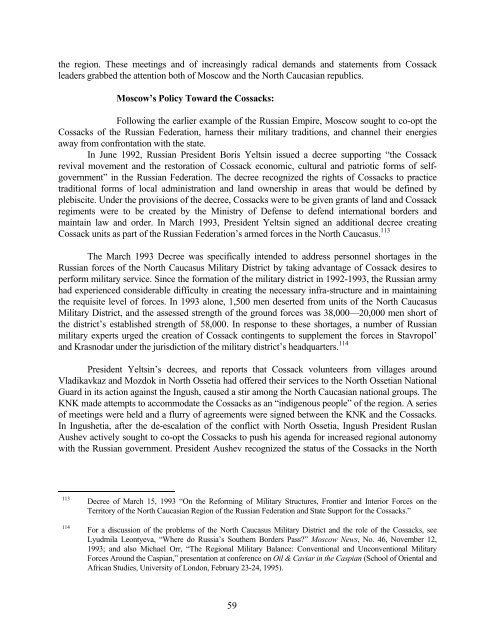RUSSIA'S TINDERBOX - Belfer Center for Science and International ...
RUSSIA'S TINDERBOX - Belfer Center for Science and International ...
RUSSIA'S TINDERBOX - Belfer Center for Science and International ...
Create successful ePaper yourself
Turn your PDF publications into a flip-book with our unique Google optimized e-Paper software.
the region. These meetings <strong>and</strong> of increasingly radical dem<strong>and</strong>s <strong>and</strong> statements from Cossack<br />
leaders grabbed the attention both of Moscow <strong>and</strong> the North Caucasian republics.<br />
Moscow’s Policy Toward the Cossacks:<br />
Following the earlier example of the Russian Empire, Moscow sought to co-opt the<br />
Cossacks of the Russian Federation, harness their military traditions, <strong>and</strong> channel their energies<br />
away from confrontation with the state.<br />
In June 1992, Russian President Boris Yeltsin issued a decree supporting “the Cossack<br />
revival movement <strong>and</strong> the restoration of Cossack economic, cultural <strong>and</strong> patriotic <strong>for</strong>ms of selfgovernment”<br />
in the Russian Federation. The decree recognized the rights of Cossacks to practice<br />
traditional <strong>for</strong>ms of local administration <strong>and</strong> l<strong>and</strong> ownership in areas that would be defined by<br />
plebiscite. Under the provisions of the decree, Cossacks were to be given grants of l<strong>and</strong> <strong>and</strong> Cossack<br />
regiments were to be created by the Ministry of Defense to defend international borders <strong>and</strong><br />
maintain law <strong>and</strong> order. In March 1993, President Yeltsin signed an additional decree creating<br />
Cossack units as part of the Russian Federation’s armed <strong>for</strong>ces in the North Caucasus. 113<br />
The March 1993 Decree was specifically intended to address personnel shortages in the<br />
Russian <strong>for</strong>ces of the North Caucasus Military District by taking advantage of Cossack desires to<br />
per<strong>for</strong>m military service. Since the <strong>for</strong>mation of the military district in 1992-1993, the Russian army<br />
had experienced considerable difficulty in creating the necessary infra-structure <strong>and</strong> in maintaining<br />
the requisite level of <strong>for</strong>ces. In 1993 alone, 1,500 men deserted from units of the North Caucasus<br />
Military District, <strong>and</strong> the assessed strength of the ground <strong>for</strong>ces was 38,000—20,000 men short of<br />
the district’s established strength of 58,000. In response to these shortages, a number of Russian<br />
military experts urged the creation of Cossack contingents to supplement the <strong>for</strong>ces in Stavropol’<br />
<strong>and</strong> Krasnodar under the jurisdiction of the military district’s headquarters. 114<br />
President Yeltsin’s decrees, <strong>and</strong> reports that Cossack volunteers from villages around<br />
Vladikavkaz <strong>and</strong> Mozdok in North Ossetia had offered their services to the North Ossetian National<br />
Guard in its action against the Ingush, caused a stir among the North Caucasian national groups. The<br />
KNK made attempts to accommodate the Cossacks as an “indigenous people” of the region. A series<br />
of meetings were held <strong>and</strong> a flurry of agreements were signed between the KNK <strong>and</strong> the Cossacks.<br />
In Ingushetia, after the de-escalation of the conflict with North Ossetia, Ingush President Ruslan<br />
Aushev actively sought to co-opt the Cossacks to push his agenda <strong>for</strong> increased regional autonomy<br />
with the Russian government. President Aushev recognized the status of the Cossacks in the North<br />
113 Decree of March 15, 1993 “On the Re<strong>for</strong>ming of Military Structures, Frontier <strong>and</strong> Interior Forces on the<br />
Territory of the North Caucasian Region of the Russian Federation <strong>and</strong> State Support <strong>for</strong> the Cossacks.”<br />
114 For a discussion of the problems of the North Caucasus Military District <strong>and</strong> the role of the Cossacks, see<br />
Lyudmila Leontyeva, “Where do Russia’s Southern Borders Pass?” Moscow News, No. 46, November 12,<br />
1993; <strong>and</strong> also Michael Orr, “The Regional Military Balance: Conventional <strong>and</strong> Unconventional Military<br />
Forces Around the Caspian,” presentation at conference on Oil & Caviar in the Caspian (School of Oriental <strong>and</strong><br />
African Studies, University of London, February 23-24, 1995).<br />
59
















